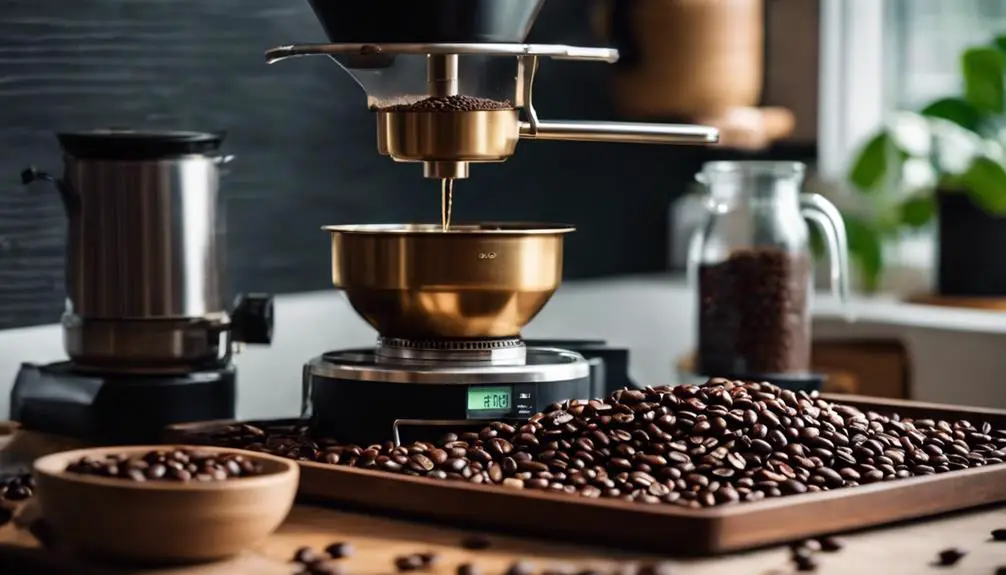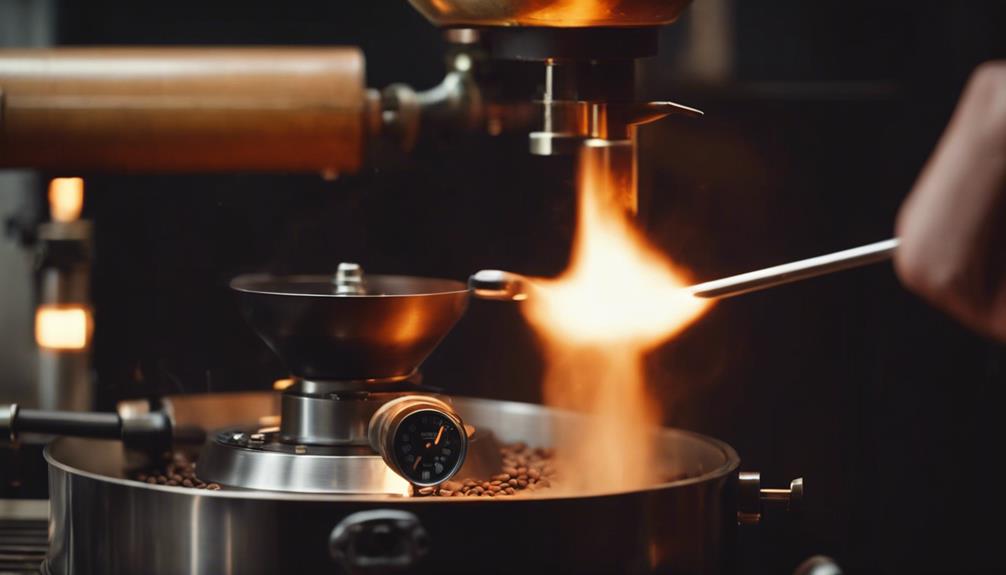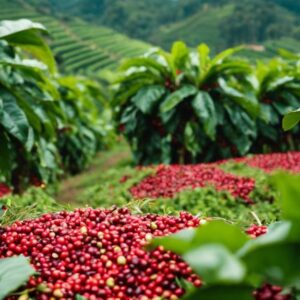To roast Arabica coffee beans successfully, you need precision and patience. As a beginner, understanding the nuances of this process is crucial for achieving that perfect cup.
From selecting the right beans to mastering the roasting profiles, every step plays a vital role in the final flavor. And as you embark on this journey of transforming green beans into a rich, aromatic brew, you’ll discover the satisfaction of creating your own custom roast.
How to Roast Arabica Coffee Beans?

When roasting Arabica coffee beans, understanding the essentials of Arabica coffee and comparing it to Robusta will help you grasp the impact of roasting on flavor.
Experimenting with different roast levels and techniques can enhance the unique characteristics of Arabica beans, allowing you to tailor the roast to your preferences.
The Essentials of Arabica Coffee
To achieve a perfect roast of Arabica coffee beans, focus on mastering the key essentials of the roasting process. Arabica coffee, known for its complex flavors and diverse origin regions, requires a delicate touch to bring out its best characteristics.
Here are three essential factors to consider when roasting Arabica coffee beans:
- Origin: Understanding the specific region where the Arabica beans were grown can provide valuable insights into the potential flavor profiles and optimal roasting techniques.
- Flavors: Arabica coffee offers a wide range of flavors, from fruity and floral notes to chocolatey undertones. Roasting methods should aim to enhance and preserve these unique taste qualities.
- Roasting Level: Finding the perfect balance between preserving the bean’s origin flavors and achieving the desired roast level is crucial for a successful Arabica coffee roast.
Arabica vs. Robusta: The Roasting Impact
Consider the impact of roasting on Arabica and Robusta coffee beans to understand how each variety responds to different roasting methods. When it comes to roasting Arabica beans specifically, here’s how it differs from Robusta:
- Aroma Development: Arabica beans tend to produce more complex and nuanced aromas during roasting compared to Robusta.
- Acidity Levels: Arabica beans typically retain their acidity better through the roasting process, resulting in a brighter and livelier cup.
- Flavor Profiles: Roasting Arabica beans often highlights their inherent flavors, such as fruity or floral notes, while Robusta beans lean towards a more bitter and earthy taste.
Understanding these nuances can help you tailor your roasting techniques to bring out the best in each type of bean.
Choosing Your Arabica Beans for Roasting

When selecting Arabica beans for roasting, it is essential to consider the origin, flavor profile, and overall quality of the beans. Tips and tricks for choosing the best beans before roasting can greatly impact the final taste of your coffee.
Pay attention to these factors to ensure a delicious and satisfying brew.
Selecting Beans: Origin, Flavor, and Quality
Selecting the right Arabica beans for roasting is crucial to achieving the best flavor and quality in your coffee. When choosing your beans, consider their origin, flavor profile, and overall quality. Here’s a quick guide to help you make the perfect selection:
| Origin | Flavor Profile |
|---|---|
| Ethiopia | Floral, Citrus |
| Colombia | Nutty, Chocolate |
| Brazil | Nutty, Sweet |
| Kenya | Bright, Fruity |
| Guatemala | Spicy, Chocolate |
Exploring different origins will not only add variety to your roasting experience but also allow you to discover unique flavor notes. Experiment with different beans to find the perfect match for your palate and elevate your coffee game to new heights.
Pre-Roast Bean Selection: Tips and Tricks
For optimal roasting results with Arabica beans, ensure you carefully assess the quality and characteristics of the beans you choose. When it comes to selection and sourcing of Arabica beans for roasting, here are some innovative tips to guide you:
- Origin Matters: Select beans from specific regions known for producing high-quality Arabica coffee, such as Ethiopian Yirgacheffe or Colombian Supremo.
- Bean Quality: Look for beans that are uniform in size, color, and texture, as these factors can influence the roasting process and overall flavor profile.
- Freshness is Key: Opt for beans that have been recently harvested and stored properly to ensure you’re working with the best possible raw material for your roasting journey.
Equipment and Setup for Roasting Arabica Beans

You’re ready to tackle the essentials of roasting equipment and setting up the perfect environment for your Arabica beans.
Gather your roasting essentials and ensure you create an ideal space for the roasting process.
Let’s set the stage for a successful roasting session.
Roasting Equipment Essentials
When it comes to roasting Arabica coffee beans, understanding the equipment essentials is key. Home roasting machines and professional gear each have their pros and cons, and setting up your home roasting station properly can make a big difference in the quality of your roast. Let’s explore the differences and setup requirements to help you get started on your coffee roasting journey.
| Home Roasting Machines | Professional Gear | Setting Up Your Home Roasting Station |
|---|---|---|
| Affordable and convenient for beginners | Offers more control and consistency | Choose a well-ventilated area with easy access to utilities |
| Limited capacity for smaller batches | Higher cost investment upfront | Ensure proper ventilation to remove smoke and chaff |
| User-friendly interfaces for easy operation | Requires more space and maintenance | Have a dedicated space for your roasting equipment and supplies |
| Limited customization options | Allows for precise adjustments | Keep all necessary tools and materials organized and within reach |
| Ideal for beginners and small-scale roasting | Suited for larger quantities and commercial use | Follow safety protocols and guidelines at all times |
Home Roasting Machines vs. Professional Gear
Consider the options available for roasting Arabica coffee beans at home or with professional gear to determine the most suitable equipment for your needs.
- Home Roasting Machines:
- Ideal for beginners.
- Compact and user-friendly.
- Great for small batches.
- Professional Gear:
- Offers precise control.
- Suitable for larger quantities.
- Requires more space and investment.
Setting Up Your Home Roasting Station
For those looking to set up their home roasting station for Arabica coffee beans, essential roasting equipment is key to achieving your desired roast profiles.
To get started, you’ll need:
- A precise roasting machine: Ensure it allows you to control temperature and roast time.
- A reliable thermometer: To monitor the roast temperature accurately.
- Roasting profiles: Experiment with different profiles to find your perfect roast.
Creating the Ideal Roasting Environment
To create the ideal roasting environment for your Arabica coffee beans, ensure you focus on three key aspects:
- Ventilation: Proper ventilation is crucial to prevent smoke buildup and ensure a clean roasting process.
- Safety: Prioritize safety by having fire extinguishers nearby and following all safety guidelines.
- Space Preparation: Arrange your roasting equipment in a well-ventilated, safe area with ample space to work comfortably and efficiently.
Ventilation, Safety, and Space Preparation
Prepare your roasting space with proper ventilation and safety measures to ensure an ideal environment for roasting Arabica coffee beans.
- Ventilation: Install a ventilation system to remove smoke and odors efficiently.
- Safety Gear: Equip yourself with safety gear like heat-resistant gloves and goggles.
- Clear Space: Ensure there’s ample space around the roaster for easy movement and access to controls.
Arabica Coffee Roasting Profiles and Techniques
When roasting Arabica coffee beans, it’s crucial to grasp the various roast levels, from light to dark. Each roast level brings out different flavors and aromas in the beans, so understanding these profiles is key to achieving your desired taste in your brewed coffee.
Experimenting with different roasting techniques can help you find the perfect balance that suits your preference.
Understanding Roast Levels: Light to Dark
When it comes to roasting Arabica coffee beans, understanding the different roast levels is crucial to achieving the perfect cup of coffee.
By learning about the flavor profiles and roasting characteristics associated with light to dark roasts, you can tailor your roasting techniques to bring out the best in Arabica beans.
Customizing roast profiles allows you to experiment and find the ideal balance of flavors that suit your preferences.
| Light Roast | Medium Roast | Medium-Dark Roast |
|---|---|---|
| Light body and acidity | Balanced flavor and aroma | Rich and slightly bitter taste |
| Retains most of the bean’s original characteristics | Slightly darker in color | Oils may start to appear on the beans |
| Bright, fruity, and floral notes | Caramelization of sugars for a sweeter taste | Bittersweet flavors with pronounced body |
Flavor Profiles and Roasting Characteristics
Wondering how the roast level of Arabica coffee beans affects their flavor profile and roasting characteristics? Arabica beans offer a wide range of flavor profiles based on the roast level.
From light roasts with bright acidity and floral notes to dark roasts with bold flavors and lower acidity, each roast brings out unique characteristics. Check out the table below for a quick overview:
| Roast Level | Flavor Profile |
|---|---|
| Light | Floral, Bright |
| Medium | Balanced, Fruity |
| Medium-Dark | Rich, Chocolatey |
| Dark | Bold, Smoky |
| Very Dark | Bitter, Charred |
Customizing Roast Profiles for Arabica Beans
To fully explore the range of flavors in Arabica coffee beans, it’s essential to understand how to customize roast profiles based on the understanding of roast levels from light to dark. When roasting Arabica beans, consider these customization tips:
- Experiment with different roasting times.
- Adjust the temperature for a unique flavor profile.
- Fine-tune the airflow to control the roast intensity.
Arabica Coffee Step-by-Step Roasting Process

When roasting Arabica coffee beans, the first step is to preheat your roaster and prepare the beans for the roast.
Next, you’ll need to master the different roasting phases to achieve the desired flavor profile.
Initiating the Roast: Preheating and Bean Preparation
Begin by preheating your roaster to the appropriate temperature and preparing your Arabica coffee beans for the roasting process. To ensure a successful start to your roasting journey, follow these steps:
- Preheating: Set your roaster to the ideal temperature for Arabica beans, typically between 370-540°F (188-282°C), depending on your desired roast profile.
- Bean Inspection: Check your beans for any defects or foreign objects and remove any debris that could affect the roasting process.
- Bean Measurement: Weigh the beans according to your batch size, ensuring consistency for an even roast.
Mastering the Roasting Phases
When roasting Arabica coffee beans, mastering the roasting phases is crucial for achieving the perfect flavor. To help you along the way, focus on three key points:
- Identifying the First and Second Cracks
- Timing and Temperature Adjustments
- Monitoring the Roasting Process Carefully
Identifying the First and Second Cracks
To successfully identify the first and second cracks during the roasting process of Arabica coffee beans, pay close attention to the distinct popping sounds that indicate the progression of the beans’ development.
- First Crack: Begins with a series of sharp cracks, resembling popcorn popping.
- Interim Period: Occurs after the first crack, beans undergo chemical changes.
- Second Crack: Follows with softer cracking sounds, indicating advanced roast levels.
Timing and Temperature Adjustments
Master the art of timing and temperature adjustments to achieve the perfect roast for your Arabica coffee beans.
- Temperature Control: Experiment with different temperatures to bring out unique flavors.
- Adjustment Precision: Make small, incremental adjustments for fine-tuning the roasting process.
- Monitoring Tools: Utilize advanced tools like thermometers for accurate temperature readings, ensuring consistency and quality in your roast.
Fine-Tuning Your Arabica Coffee Roasting Technique
When fine-tuning your Arabica coffee roasting technique, pay close attention to the color, smell, and sound of the roast. These indicators will guide you in making necessary adjustments for achieving the perfect roast quality.
Experiment with these factors to enhance your coffee roasting skills and develop a personalized technique.
Monitoring the Roast: Color, Smell, and Sound
For a more precise roasting technique with Arabica coffee beans, pay close attention to the color, smell, and sound during the roasting process. Here’s how you can fine-tune your roast:
- Color: Watch for the transformation of the beans from green to yellow, then to various shades of brown. Aim for a medium brown color for a balanced flavor profile.
- Smell: Notice the evolving aromas during the roast. You should detect grassy notes turning into nutty and caramel scents, signaling the progression of the roast.
- Sound: Listen for the distinct cracking sounds. The first crack indicates the beans are reaching a light roast, while the second crack signifies a darker roast. Pay attention to these auditory cues for optimal roast development.
Adjustments for Perfecting Roast Quality
Fine-tune your Arabica coffee roasting technique by making subtle adjustments to ensure the perfect roast quality. To elevate your roasting game and achieve unparalleled quality, consider the following innovative tweaks:
- Temperature Precision: Experiment with small temperature adjustments during different stages of roasting to bring out nuanced flavors and aromas.
- Airflow Control: Fine-tune the airflow in your roaster to influence the development of the beans, leading to a more consistent and high-quality roast.
- Roast Time Variations: Explore how slight alterations in roast time can impact the final product, allowing you to tailor the roast to your preferred quality profile.
After the Roast: Arabica Coffee Cooling, De-gassing, and Storing

Once you’ve roasted your Arabica coffee beans to perfection, it’s crucial to cool them down efficiently and let them de-gas. Proper cooling and de-gassing techniques are key to preserving the flavors you worked so hard to develop.
Additionally, storing your freshly roasted beans correctly will help maintain their peak freshness for longer periods.
Cooling and De-gassing Techniques
When cooling and de-gassing your freshly roasted Arabica coffee beans, remember these essential points:
- Rapid Cooling Methods: Quick cooling helps lock in flavors and prevent over-roasting.
- Why De-gassing is Crucial: Allowing the beans to de-gas after roasting ensures a smoother, more balanced cup of coffee.
- Proper Storage Techniques: Storing your beans correctly maintains their freshness and flavor profile.
Rapid Cooling Methods
To rapidly cool freshly roasted Arabica coffee beans, consider using a dedicated cooling tray or a colander placed in front of a fan. When it comes to rapid cooling methods, innovation is key. Try these techniques for efficient cooling and de-gassing:
- Air Blast Cooler: Utilize a specialized air blast cooler to quickly bring down the temperature.
- Water Cooling: Experiment with water cooling methods to rapidly cool the beans.
- Freezer Shock: Give the beans a quick freeze in the freezer for a unique cooling approach.
Why De-gassing is Crucial
After rapidly cooling your freshly roasted Arabica coffee beans, you’ll want to understand why de-gassing is a crucial step in the process.
De-gassing: Allows built-up CO2 to escape, preventing off-flavors.
Preserves Freshness: Enhances flavor development post-roast.
Aids in Brewing: Reduces the chance of uneven extraction during brewing.
De-gassing is of utmost importance to ensure your Arabica coffee beans reach their full flavor potential.
Storage Solutions for Maintaining Freshness
When it comes to maintaining the freshness of your freshly roasted Arabica coffee beans, proper storage is key. Consider the containers and conditions you store your beans in, as they greatly impact the flavor of your brew.
Let’s explore the optimal storage solutions to preserve the quality of your coffee.
| Containers for Storage | Conditions for Storage |
|---|---|
| Airtight containers | Cool, dark place |
| Opaque containers | Avoid temperature fluctuations |
| Vacuum-sealed bags | Low humidity environment |
| Ceramic jars | Away from direct sunlight |
| Glass jars | Free from strong odors |
Containers and Conditions for Optimal Storage
For optimal storage of freshly roasted Arabica coffee beans, ensure you use containers that are airtight and placed in a cool, dark location.
- Utilize vacuum-sealed containers to preserve freshness.
- Store away from light to prevent flavor degradation.
- Maintain consistent temperature and humidity levels for longer-lasting quality.
The Impact of Storage on Flavor
Wondering how storage conditions can impact the flavor of your freshly roasted Arabica coffee beans? When it comes to maintaining the exquisite taste of your beans, consider the following:
- Temperature Control: Keep your beans away from heat and direct sunlight to preserve their flavor.
- Airtight Containers: Store your coffee in airtight containers to prevent exposure to oxygen, which can degrade the flavor.
- Avoid Moisture: Moisture can lead to mold growth and spoil the flavor of your coffee beans.
Beyond Basics: Advanced Arabica Roasting Strategies
Now that you’ve mastered the basics of roasting Arabica coffee beans, it’s time to elevate your skills.
Experiment with blending Arabica beans to create unique flavor profiles and tailor your roasts to suit different brewing methods.
These advanced strategies will allow you to fine-tune your roasting process and craft exceptional coffee experiences.
Blending Arabica Beans for Unique Flavors
When blending Arabica beans for unique flavors, keep in mind three key points:
- Understand the art of creating coffee blends.
- Consider the differences between blending pre-roast and post-roast.
- Experiment with various combinations to achieve your desired taste profile.
The Art of Creating Coffee Blends
To create unique flavors in your coffee blends, consider blending Arabica beans using advanced roasting strategies.
- Experiment with Different Roast Levels: Try blending light, medium, and dark roast Arabica beans to enhance complexity.
- Incorporate Single-Origin Beans: Mix beans from different regions to add diverse flavor profiles.
- Explore Flavor Pairings: Combine beans with complementary flavor notes like fruity and nutty for a harmonious blend.
Blending Pre vs. Post-Roast
Blending pre-roast and post-roast Arabica beans offers a dynamic way to craft complex and unique flavor profiles in your coffee blends. To master this innovative technique, follow these steps:
- Experiment: Try blending different ratios of pre and post-roast beans to discover new flavors.
- Roast Separately: Roast some beans before blending to enhance certain characteristics.
- Adjust Grind: Fine-tune your grind size to achieve the perfect blend preparation.
Tailoring Roasts to Brewing Methods
When tailoring roasts to different brewing methods, you’ll need to consider the specific characteristics that each method brings out in the coffee. Here are three key points to keep in mind:
- Specific Roasts for Espresso: Espresso demands a finely ground coffee with a rich, bold flavor profile that stands up to the intensity of the brewing process.
- Specific Roasts for French Press: French press brewing benefits from a coarser grind and a medium to dark roast that imparts a full-bodied and robust taste.
- Specific Roasts for Other Methods: Experiment with lighter roasts for pour-over methods and medium roasts for drip coffee to highlight nuanced flavors while maintaining balance.
Specific Roasts for Espresso, French Press, and More
When considering specific roasts for espresso, French press, and other brewing methods, it’s essential to understand the impact of roast levels on flavor profiles.
- Espresso: Opt for a medium to dark roast to bring out rich, bold flavors that can cut through milk-based drinks.
- French Press: Try a medium roast for a balanced taste with a fuller body and pronounced sweetness.
- Pour-Over: Experiment with a light to medium roast for bright, complex flavors and a clean finish.
Safety and Maintenance in Arabica Coffee Roasting
When roasting Arabica coffee beans, handling smoke and chaff efficiently is crucial for safety.
Adopt safe roasting practices to prevent accidents and ensure a smooth roasting process.
Prioritize maintenance tasks to keep your roasting equipment in top condition for optimal results.
Handling Smoke and Chaff Efficiently
When roasting Arabica coffee beans, handling smoke and chaff efficiently is crucial for safety and maintaining your equipment. To do this effectively, consider the following:
- Ventilation Systems: Ensure proper airflow to manage smoke and prevent buildup.
- Home Safety: Keep fire safety measures in mind during roasting to avoid accidents.
- Cleanliness and Maintenance: Regularly clean your roaster to prolong its lifespan and maintain the quality of your coffee.
Ventilation Systems and Home Safety
To efficiently handle smoke and chaff during Arabica coffee roasting at home, ensure your ventilation system is properly installed and functioning effectively.
- Smart Sensors: Integrate temperature control sensors for automatic adjustments.
- High-Performance Fans: Invest in powerful fans for effective smoke extraction.
- Safety Alarms: Install alarms for monitoring air quality and ensuring a safe roasting environment.
Cleanliness and Maintenance for Longevity
For efficient handling of smoke and chaff during Arabica coffee roasting at home, prioritize regular cleaning and maintenance of your roasting equipment.
- Clean Regularly: Wipe down surfaces to prevent buildup that could lead to smoke production.
- Inspect Equipment: Check for any signs of wear and tear to address maintenance needs promptly.
- Proper Storage: Store your roasting equipment in a clean and dry environment to prolong its lifespan.
Adopting Safe Roasting Practices
When it comes to roasting Arabica coffee beans safely, remember to prioritize your well-being and the maintenance of your equipment. Ensure you follow these essential points:
- Wear necessary safety gear such as heat-resistant gloves and goggles.
- Adopt best practices like proper ventilation to minimize smoke exposure.
- Regularly inspect and maintain your roasting equipment for optimal performance.
Personal Safety Gear and Best Practices
Ensuring your personal safety during the roasting process involves the proper use of safety gear and adhering to best practices.
- Wear protective gear: Invest in heat-resistant gloves, goggles, and an apron to shield yourself from potential burns and smoke inhalation.
- Maintain a clean workspace: Keep your roasting area clutter-free to prevent accidents and ensure easy movement.
- Follow safety guidelines: Familiarize yourself with the equipment manual and adhere to recommended safety protocols at all times.
Routine Equipment Checks and Maintenance
Are you regularly conducting routine equipment checks and maintenance to ensure the safe operation of your Arabica coffee roasting setup?
To maintain optimal performance and safety, consider the following:
- Regular Temperature Monitoring: Use digital thermometers for accurate readings.
- Cleaning Schedule: Implement a cleaning routine to prevent build-up and maintain efficiency.
- Ventilation Inspection: Ensure proper ventilation to prevent overheating and maintain air quality.
Enjoying Your Roasted Arabica Beans

Now that your Arabica beans are perfectly roasted, it’s time to savor the fruits of your labor.
Brewing a fresh cup with those aromatic beans will elevate your coffee experience to a whole new level.
Get ready to indulge in the rich flavors and enticing aromas of your freshly roasted Arabica coffee.
Brewing the Best with Freshly Roasted Beans
When it comes to enjoying your freshly roasted Arabica beans, there are a few key points to keep in mind. To make the most of your coffee experience, consider the following:
- Brewing Techniques for Highlighting Roast Profiles
- Coffee and Food Pairings
- Proper Storage and Freshness
Brewing Techniques for Highlighting Roast Profiles
To truly savor the rich flavors of your freshly roasted Arabica beans, consider exploring various brewing techniques that highlight their unique roast profiles.
- Cold Brewing: Extracts the beans’ subtle flavors without the bitterness.
- Pour-Over Technique: Allows for precise control over extraction, enhancing nuanced flavors.
- AeroPress Method: Produces a smooth and rich cup by using air pressure for extraction.
Experimenting with these techniques will elevate your coffee experience to new heights.
Coffee and Food Pairings
Enhance your coffee experience by exploring optimal food pairings that complement the flavors of your freshly roasted Arabica beans.
- Citrus Delights: Pair your coffee with lemon tarts or orange-infused pastries to enhance the citrus notes in your brew.
- Nutty Complements: Enjoy your coffee with almond biscotti or hazelnut chocolate for a delightful nutty pairing.
- Savory Selections: Try pairing your coffee with bacon-wrapped dates or aged gouda for a savory aroma experience.
Troubleshooting Common Arabica Coffee Roasting Challenges

If you’re facing issues like uneven roasts or burnt beans, don’t worry; there are solutions.
You can also learn how to manage roasting smoke and odors effectively in your home setup.
Let’s tackle these common challenges together to improve your Arabica coffee roasting experience.
Fixing Uneven Roasts and Avoiding Burnt Beans
Achieving an even roast and preventing burnt beans is crucial for mastering the art of roasting Arabica coffee beans. To fix uneven roasts and avoid burnt beans, follow these innovative tips:
- Monitor Temperature: Use a reliable thermometer to ensure consistent heat throughout the roasting process. Adjust the temperature as needed to prevent scorching and achieve a uniform roast.
- Stir Regularly: Keep the beans moving during roasting to promote even heat distribution. Stirring prevents hot spots and helps all beans roast uniformly.
- Use Proper Ventilation: Adequate airflow is essential to prevent beans from overheating. Ensure your roasting setup has good ventilation to avoid burnt flavors and maintain consistency in the roast profile.
Managing Roasting Smoke and Odors at Home
To tackle the challenge of managing roasting smoke and odors at home while roasting Arabica coffee beans, consider implementing effective ventilation strategies. Here are three innovative ways to keep your environment smoke-free and smelling fresh:
- Invest in a Quality Ventilation System: Install a powerful range hood or ventilation fan in your roasting area to help capture and remove smoke and odors efficiently.
- Use a Smoke Filter: Consider using a specialized smoke filter designed for home roasting setups to minimize the release of odors into your surroundings.
- Roast Outdoors: If possible, take your roasting operation outside to prevent smoke and odors from lingering in your home environment. Outdoor roasting can also be a delightful experience, connecting you more closely with the roasting process while keeping your indoor air clean.
Roasting Arabica Beans: FAQs and Expert Advice

When roasting Arabica beans, optimizing your roasting schedule is key to achieving the perfect flavor profile.
Understand the do’s and don’ts of re-roasting to avoid compromising the quality of your beans.
Expert advice on these points can help elevate your coffee roasting skills to the next level.
Optimizing Your Roasting Schedule
Considering the optimal timing for your roasting sessions can significantly impact the flavor profile of your Arabica coffee beans. To optimize your roasting schedule, follow these innovative tips:
- Monitor Temperature Changes: Keep a close eye on the roasting temperature throughout the process to ensure consistency and desired flavor development.
- Experiment with Roasting Times: Try varying the roasting times to discover the perfect balance between achieving the desired roast level and preserving the beans’ unique characteristics.
- Establish a Roasting Frequency: Determine a regular roasting schedule that suits your consumption needs and allows you to consistently enjoy freshly roasted Arabica coffee.
Re-Roasting: Do’s and Don’ts
For optimal results, approach re-roasting Arabica coffee beans with caution and attentiveness. Re-roasting can enhance the quality and flavor of your beans if done correctly. Here are some do’s and don’ts to keep in mind:
- Do Monitor Closely: Pay close attention to the beans during the re-roasting process to avoid burning or over-roasting, which can negatively impact the flavor.
- Don’t Rush the Process: Take your time when re-roasting; rushing can lead to uneven roasting and inconsistent flavor development.
- Do Experiment Safely: Feel free to experiment with different re-roasting techniques to find the perfect balance between enhancing the quality and flavor of your Arabica beans.
Conclusion
Now that you’ve mastered the art of roasting Arabica coffee beans, get ready to savor the most exquisite cup of coffee you’ve ever tasted!
With a little practice and patience, you’ll be brewing up a storm of flavor that will blow your taste buds away.
So grab your freshly roasted beans, fire up your coffee maker, and get ready to experience a caffeine kick like never before.
Cheers to your newfound coffee roasting expertise!






















